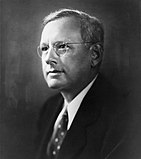User:Cheef117/sandbox
| |||
531 members of the Electoral College 266 electoral votes needed to win | |||
|---|---|---|---|
| Turnout | 71.8% | ||
 Presidential election results map. Red denotes states won by Coolidge/Dawes, blue denotes those won by Davis/Bryan, light green denotes Wisconsin, the state won by La Follette/Wheeler. Numbers indicate the number of electoral votes allotted to each state. | |||
| |||
←
| Battle of Dogger Bank | |||||||
|---|---|---|---|---|---|---|---|
| Part of Second World War | |||||||
 German battleship Bismarck firing her guns during the battle | |||||||
| |||||||
| Belligerents | |||||||
|
|
| ||||||
| Commanders and leaders | |||||||
|
|
| ||||||
| Strength | |||||||
|
2 aircraft carriers |
3 aircraft carriers | ||||||
| Casualties and losses | |||||||
|
2 destroyers sunk |
1 battleship sunk, 2 lightly damaged | ||||||
The Battle of Dogger Bank was a naval battle fought during the Second World War on April 15, 1942, between the German Imperial Navy and the British Royal Navy. Admiral Erich Raeder, ranking officer within the German Navy, led the bulk of the German surface fleet into the North Sea to lure the British out to a fight. Admiral Andrew Cunningham, commander of the Home Fleet, sortied out with the intention of destroying Raeder's force. It was the first major naval battle between the German Empire and the United Kingdom during the war and, at the time, the largest naval battle in history if counting by total tonnage of ships involved (beating the Battle of Jutland).
Admiral Raeder (like Vice Admiral Reinhard Scheer before him at Jutland) planned to lure out a portion of the Royal Navy with the presence of his ships, and then destroy them piecemeal. With the completion of training trials for his new aircraft carriers Graf Zeppelin and Seydlitz, he could risk bringing his fleet to battle with British aircraft carriers. Making Graf Zeppelin his flagship, he commanded the so-called "Main Task Group". He delegated command of the battleships Bismarck and Tirpitz, along with the battlecruiser Roon and other fast ships, to Vice Admiral Saalwächter, commanding the "Fast Reaction Group".
With the intelligence community at Bletchley Park having uncovered the planned German sortie, Admiral Cunningham sortied his own ships; he too made a carrier, HMS Illustrious, his flagship. He put Vice Admiral Somerville in command of the "Quick Squadron" of battlecruisers and fast battleships; HMS Hood was his flagship.
The battle began when Somerville's Quick Squadron came into contact with Saalwächter's Fast Reaction Group; Somerville then turned south, with the intention of leading the German battlecruisers and fast battleships towards the carriers and battleships of Cunningham's main force. Saalwächter suspected this and radioed Raeder to come to his aid. As the two fast fleets continued the gunnery duel (resulting in heavy damage to HMS Repulse, which had to disengage southwest), aircraft from both fleet's carriers began to engage each other over the scene of the battle. Raeder dispatched the battleships Scharnhorst and Gneisenau to join Saalwächter's force; at the same time, German torpedo bombers fatally wounded Somerville's flagship, HMS Hood; after being wounded by machine-gun fire, he was brought aboard a nearby destroyer, and Hood sank 10 minutes later. After another half hour of gunnery duel, the battleship HMS Barham was struck by a salvo of 15-inch shells from the battleship Bismarck which ignited her aft magazine, destroying the ship and instantly killing over 840 of her crew. At 1312 hours, Cunningham disengaged towards the West.
The battle was immediately recognized as a stunning German victory. The newly-revived Kaiserliche Marine, having suffered defeat during World War I and being severely outnumbered at the start of World War II, had fought the Royal Navy openly in the North Sea and defeated it despite being outnumbered. As a result of public outcry and the displeasure of the admiralty, Admiral Cunningham was redeployed to serve in the Indian Ocean. Somerville, having shown bravery and skill in the first phase of the battle despite being wounded, was promoted to full Admiral and given command over the Home Fleet.
In Germany, the battle was met with jubilation. Raeder was promoted to the rank of full Grand Admiral, and both he and Saalwächter were rewarded as Commanders of the House Order of Hohenzollern; furthermore, Raeder received the Grand Cross of the Iron Cross, having received the Iron Cross 1st Class during the First World War.
| Exercise One | |||||||
|---|---|---|---|---|---|---|---|
| |||||||
| Belligerents | |||||||
|
|
| ||||||
| Commanders and leaders | |||||||
|
|
| ||||||
| Units involved | |||||||
| Battle Fleet | Scouting Fleet | ||||||
| Strength | |||||||
|
3 pocket battleships |
2 light carriers | ||||||
| Casualties and losses | |||||||
|
1 pocket battleship sunk, 1 damaged |
2 destroyers damaged | ||||||
| June Revolution | |||||||
|---|---|---|---|---|---|---|---|
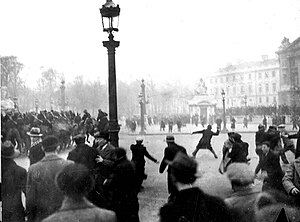 Revolutionaries attack a unit of mounted police, June 19 | |||||||
| |||||||
| Belligerents | |||||||
|
| French revolutionaries/People's Republic of France | ||||||
| Commanders and leaders | |||||||
|
| |||||||
| Units involved | |||||||
|
Most of the Gendarmerie |
Elements of the Gendarmerie About half of the French Army | ||||||
| Strength | |||||||
|
2,000 Republican Guard 6,500 Gendarmerie |
Unknown number of Republican Guard 2,000 Gendarmerie At least 150,000 men | ||||||
| Casualties and losses | |||||||
|
Several dozen Republican Guard 250 Gendarmerie 870 men (executed) 1,556 men (battle) |
Several dozen Gendarmerie 1,218 men (battle) About 1,000 citizens | ||||||
| Battle of Philadelphia | |||||||
|---|---|---|---|---|---|---|---|
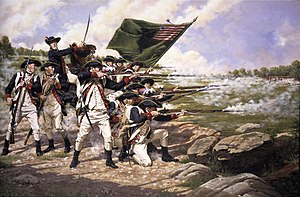 Delaware troops at the Battle of Philadelphia | |||||||
| |||||||
| Belligerents | |||||||
|
|
| ||||||
| Commanders and leaders | |||||||
|
|
| ||||||
| Strength | |||||||
|
5,100 men 15 guns |
9,900 men 40 guns | ||||||
| Casualties and losses | |||||||
| 529 killed, wounded, and missing | 398 killed, wounded, and missing | ||||||
| Paulskirche Massacre | ||||||||
|---|---|---|---|---|---|---|---|---|
| ||||||||
| Belligerents | ||||||||
| Shoeless savages | National Assembly of Germany | Ebin Nocobins | ||||||
| Commanders and leaders | ||||||||
| Unknown |
Alexander Nast† Julius Kühn (wounded) | Georg Wolfsegen | ||||||
| Strength | ||||||||
| 5,000, potentially more (all without shoes) | 497 delegates | 3 men with no honor | ||||||
| Casualties and losses | ||||||||
| None | 57 killed, over 300 wounded | A pair of shoes | ||||||
| Battle of Marshfield | |||||||
|---|---|---|---|---|---|---|---|
| Part of American Revolutionary War | |||||||
| |||||||
| Belligerents | |||||||
|
|
| ||||||
| Commanders and leaders | |||||||
|
|
| ||||||
| Strength | |||||||
| 9,000, 31 guns | 5,946, 16 guns | ||||||
| Casualties and losses | |||||||
| 298 killed, wounded, and missing | 257 killed, wounded, and missing | ||||||
| Second Korean War | |||||||
|---|---|---|---|---|---|---|---|
| |||||||
| Participants | |||||||
|
| ||||||
| Commanders and leaders | |||||||
|
|
| ||||||
| Casualties and losses | |||||||
|
|
| ||||||
| Battle of Jeju Strait | |||||||
|---|---|---|---|---|---|---|---|
| Part of Russo-Japanese War | |||||||
 The Japanese Combined Fleet sailing to battle | |||||||
| |||||||
| Belligerents | |||||||
|
|
| ||||||
| Commanders and leaders | |||||||
|
|
| ||||||
| Units involved | |||||||
|
|
| ||||||
| Strength | |||||||
|
12 battleships 6 armored cruisers 7 light cruisers 18 destroyers and torpedo boats |
6 battleships 5 armored cruisers 9 light cruisers 23 destroyers and torpedo boats | ||||||
| Casualties and losses | |||||||
|
1 battleship 1 armored cruiser 2 light cruisers 2 destroyers 1,106 sailors killed and wounded |
1 battleship 2 light cruisers 3 destroyers 1,284 sailors killed and wounded | ||||||
| |||||||||||||||||||||||||||||
All 483 electoral votes of the Electoral College 242 electoral votes needed to win | |||||||||||||||||||||||||||||
|---|---|---|---|---|---|---|---|---|---|---|---|---|---|---|---|---|---|---|---|---|---|---|---|---|---|---|---|---|---|
| |||||||||||||||||||||||||||||
 Presidential election results map. Blue denotes states won by Parker/Davis, Red denotes those won by Roosevelt/Fairbanks, and light green denotes those won by Bryan/Watson. Numbers indicate the number of electoral votes allotted to each state. | |||||||||||||||||||||||||||||
| |||||||||||||||||||||||||||||
| Northern Virginia Campaign | |||||||
|---|---|---|---|---|---|---|---|
| Part of American Civil War | |||||||
 George B. McClellan and Robert E. Lee, respective commanders of the Union (American Civil War) Army of the Potomac and Confederate Army of Northern Virginia during the Northern Virginia Campaign | |||||||
| |||||||
| Belligerents | |||||||
|
|
| ||||||
| Commanders and leaders | |||||||
|
|
| ||||||
| Units involved | |||||||
| Army of the Potomac | Army of Northern Virginia | ||||||
| Strength | |||||||
| 99,375※※ "deployed" | 43,850 "present for service" | ||||||
| Casualties and losses | |||||||
| 20,037 | 17,195 | ||||||
|
※ Many individual battles were Union tactical victories, though McClellan failed to seize the initiative ※※ About 26,000 present in the Valley Campaign and not present for most of the fighting | |||||||
| Battle of Goodwin Hollow (Battle of Lebanon) | |||||||
|---|---|---|---|---|---|---|---|
| Part of American Civil War | |||||||
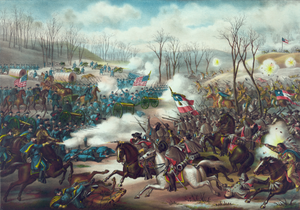 The Battle of Goodwin Hollow, Missouri. by Kurz and Allison | |||||||
| |||||||
| Belligerents | |||||||
|
|
| ||||||
| Commanders and leaders | |||||||
|
|
| ||||||
| Units involved | |||||||
| Army of the West | Army of Arkansas | ||||||
| Strength | |||||||
| 18,035 "present for duty" | 9,500 | ||||||
| Casualties and losses | |||||||
| 1,063 | 1,686 | ||||||
| Battle of Bowling Green | |||||||
|---|---|---|---|---|---|---|---|
| Part of American Civil War | |||||||
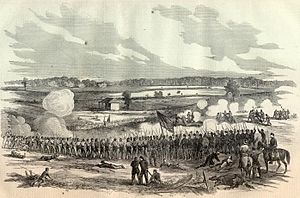 Union troops at the Battle of Bowling Green. | |||||||
| |||||||
| Belligerents | |||||||
|
|
| ||||||
| Commanders and leaders | |||||||
|
|
| ||||||
| Units involved | |||||||
| Army of the Kentucky | Army of Kentucky | ||||||
| Strength | |||||||
| 47,000 | 49,000 | ||||||
| Casualties and losses | |||||||
| 10,262 | 11,110 | ||||||
| Jackson's Valley-Maryland Campaign | |||||||
|---|---|---|---|---|---|---|---|
| Part of American Civil War | |||||||
 The Battle of Cross Keys | |||||||
| |||||||
| Belligerents | |||||||
|
|
| ||||||
| Commanders and leaders | |||||||
|
|
| ||||||
| Units involved | |||||||
|
Army of the Potomac *III Corps *IV Corps |
Army of Northern Virginia *Jackson's wing | ||||||
| Strength | |||||||
| 25,000 | 6,400 | ||||||
| Casualties and losses | |||||||
| 3,055 | 1,188 | ||||||
| Battle of Warsaw | |||||||
|---|---|---|---|---|---|---|---|
| Part of Twelve Months' War (Poland Campaign) | |||||||
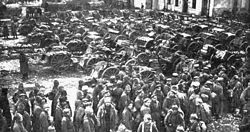 Russian prisoners after the battle, December 1907 | |||||||
| |||||||
| Belligerents | |||||||
|
|
| ||||||
| Commanders and leaders | |||||||
|
|
| ||||||
| Units involved | |||||||
|
|
| ||||||
| Strength | |||||||
|
Total: Over 500,000 |
| ||||||
| Casualties and losses | |||||||
|
Total: Up to 200,000 killed, wounded, and missing |
Over 100,000 captured | ||||||
| Battle of Pazardzhik | |||||||
|---|---|---|---|---|---|---|---|
| Part of Balkan War | |||||||
 By the Bayonet, depicting a Bulgarian soldier charging Ottoman lines | |||||||
| |||||||
| Belligerents | |||||||
|
|
| ||||||
| Commanders and leaders | |||||||
|
|
| ||||||
| Units involved | |||||||
|
|
| ||||||
| Strength | |||||||
|
89,000 men 160 guns |
75,312 men "present for duty" 183 guns | ||||||
| Casualties and losses | |||||||
| Up to 22,000 killed, wounded, and missing | 26,365 killed, wounded, and missing | ||||||
| Second Battle of Tonghua | |||||||
|---|---|---|---|---|---|---|---|
| Part of Russo-Japanese War | |||||||
 One of many failed Japanese assaults on Russian positions during the battle | |||||||
| |||||||
| Belligerents | |||||||
|
|
| ||||||
| Commanders and leaders | |||||||
|
|
| ||||||
| Units involved | |||||||
|
|
| ||||||
| Strength | |||||||
|
|
| ||||||
| Casualties and losses | |||||||
| 39,818 | 41,700 (estimated) | ||||||
| Bowling Green Campaign | |||||||
|---|---|---|---|---|---|---|---|
| Part of American Civil War | |||||||
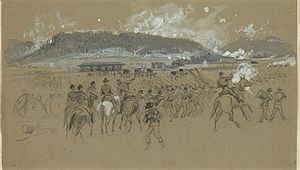 Union troops advancing on Confederate positions at Franklin, 11 September 1862 | |||||||
| |||||||
| Belligerents | |||||||
|
|
| ||||||
| Commanders and leaders | |||||||
|
|
| ||||||
| Units involved | |||||||
|
Army of the Kentucky Army of the Ohio | Army of Kentucky | ||||||
| Strength | |||||||
| 48,000 | 45,000 | ||||||
| Casualties and losses | |||||||
| 9,148 | 8,100 – 8,267 | ||||||
| Battle of Stones River (Second Battle of Murfreesboro) | |||||||
|---|---|---|---|---|---|---|---|
| Part of American Civil War | |||||||
 Union troops of Thomas' XXII Corps at Stones River | |||||||
| |||||||
| Belligerents | |||||||
|
|
| ||||||
| Commanders and leaders | |||||||
|
|
| ||||||
| Units involved | |||||||
| Army of the Tennessee | Army of Tennessee | ||||||
| Strength | |||||||
| 45,000 | 44,000 | ||||||
| Casualties and losses | |||||||
| 13,977 | 10,947 | ||||||
| Battle of London | |||||||
|---|---|---|---|---|---|---|---|
| Part of American Civil War | |||||||
 Union troops storming Confederate positions, 11 March 1863 | |||||||
| |||||||
| Belligerents | |||||||
|
|
| ||||||
| Commanders and leaders | |||||||
|
|
| ||||||
| Units involved | |||||||
| Army of the Kentucky | Army of Tennessee | ||||||
| Strength | |||||||
| 32,000 | 7,600 | ||||||
| Casualties and losses | |||||||
| 2,152 |
7,600 1,800 killed 5,800 captured | ||||||
| Battle of the Ohio | |||||||
|---|---|---|---|---|---|---|---|
| Part of Kaintuck War | |||||||
 The Cherokee overrun the French battery, 1867 | |||||||
| |||||||
| Belligerents | |||||||
|
| Cherokee | ||||||
| Commanders and leaders | |||||||
|
| Chief Rough Saddle † | ||||||
| Strength | |||||||
|
1700 infantry 350 cavalry 12 guns Total: 2,300 |
1100 infantry 400 cavalry 1 gun Total: 1600 | ||||||
| Casualties and losses | |||||||
|
199 killed Around 350 wounded 47 missing Total: About 600 | 694 – 900 | ||||||
| Battle of Chambersburg | |||||||
|---|---|---|---|---|---|---|---|
| Part of American Civil War | |||||||
 Meade leads VI Corps during Longstreet's advance | |||||||
| |||||||
| Belligerents | |||||||
|
|
| ||||||
| Commanders and leaders | |||||||
|
|
| ||||||
| Units involved | |||||||
| Army of the Potomac | Army of Northern Virginia | ||||||
| Strength | |||||||
| 94,000 | 71,000 | ||||||
| Casualties and losses | |||||||
|
3,656 killed 14,701 wounded 5,617 captured/missing Total: 24,374 |
2,995 killed 16,894 wounded 1,641 captured/missing Total: 21,530 | ||||||
| Battle of Danevirke | |||||
|---|---|---|---|---|---|
| Part of Second Schleswig War | |||||
 Danish troops counterattack at Danevirke, date unknown | |||||
| |||||
| Belligerents | |||||
|
|
| ||||
| Commanders and leaders | |||||
|
|
| ||||
| Strength | |||||
|
|
| ||||
| Casualties and losses | |||||
| Up to 2,000 total | 1,362–2,400 | ||||
| New York Revolution | |||||||
|---|---|---|---|---|---|---|---|
| Part of Presidency of Donald Trump | |||||||
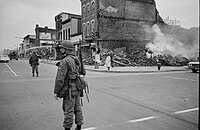 Fighting in Harlem | |||||||
| |||||||
| Belligerents | |||||||
|
|
| ||||||
| Commanders and leaders | |||||||
|
|
| ||||||
| Units involved | |||||||
|
|
| ||||||
| Strength | |||||||
|
|
| ||||||
| Casualties and losses | |||||||
| Up to 200 killed; 3,613 wounded; 230–400 missing | 6000–9000 killed, wounded, and missing | ||||||
| War of the Final Coalition | |||||||
|---|---|---|---|---|---|---|---|
| Part of Collapse of the British Empire | |||||||
 The Battle of Woking | |||||||
| |||||||
| Belligerents | |||||||
|
|
Coalition of the Willing | ||||||
| Commanders and leaders | |||||||
|
| |||||||
| Units involved | |||||||
| The Legions of Hell | The greatest armed force ever assembled in the history of mankind | ||||||
| Strength | |||||||
| 600,000–800,000 | Up to 5,000,000 | ||||||
| Casualties and losses | |||||||
| Innumerable | Heavy | ||||||
| Sino-Soviet border war "Harbin incident" | |||||||
|---|---|---|---|---|---|---|---|
 Soviet troops carrying captured NRA banners | |||||||
| |||||||
| Belligerents | |||||||
|
|
| ||||||
| Commanders and leaders | |||||||
|
|
| ||||||
| Units involved | |||||||
|
Northeastern Army
|
Special Red Banner Far Eastern Army
| ||||||
| Strength | |||||||
|
~160,000 6 tanks 25 aircraft |
100,000 at peak 40 tanks 75+ aircraft | ||||||
| Casualties and losses | |||||||
|
2200 killed 1500+ wounded 837 captured 430 missing 4 aircraft TOTAL: 4,815 |
600—800 killed 1500 wounded ~190 captured 150 missing 8 aircraft 4 tanks TOTAL: 2300—2700 | ||||||
| Attempted coup of Donald Trump | |||||||
|---|---|---|---|---|---|---|---|
| Part of Presidency of Donald Trump | |||||||
 The aftermath of a bomb explosion in downtown Washington, DC | |||||||
| |||||||
| Belligerents | |||||||
| |||||||
| Commanders and leaders | |||||||
|
| |||||||
| Units involved | |||||||
|
|
| ||||||
| Strength | |||||||
|
|
| ||||||
| Battle of Cape Verde | |||||||
|---|---|---|---|---|---|---|---|
| Part of Second World War | |||||||
 SMS Bismarck firing on British and French warships on 18 August. | |||||||
| |||||||
| Belligerents | |||||||
|
|
| ||||||
| Commanders and leaders | |||||||
|
|
| ||||||
| Strength | |||||||
|
10 fleet carriers 2 light carriers 14 battleships 6 battlecruisers 8 heavy cruisers 14 light cruisers 85 destroyers 4–6 submarines |
8 fleet carriers 4 light carriers 7 battleships 4 battlecruisers 8 heavy cruisers 19 light cruisers 67 destroyers 6 submarines | ||||||
| Casualties and losses | |||||||
|
1 fleet carrier 2 battleships 1 heavy cruiser 117 aircraft 1,530 killed |
3 fleet carriers 1 light carrier 1 battleship 1 battlecruiser 2 destroyers 1 submarine ~350 aircraft 4,682 killed | ||||||
| Battle of Kungälv | |||||||
|---|---|---|---|---|---|---|---|
| |||||||
| Belligerents | |||||||
|
|
| ||||||
| Commanders and leaders | |||||||
|
|
| ||||||
| Strength | |||||||
|
4400 levy (incl. 1500 archers) 1200 men at arms (incl. 200 knights) | 3500–5000, including 500 knights | ||||||
| Casualties and losses | |||||||
| 300–400 levy, approximately 200 cavalry | Over 2000 | ||||||
| Personal information | |
|---|---|
| Born | 21 May 2004 Long Island, New York |
| Nationality | American |
| Listed height | 6 ft 4 in (1.93 m) |
| Listed weight | 212 lb (96 kg) |
| Career information | |
| High school | Ward Melville High School |
| College | Bucknell University (2022–26) |
| NBA draft | 2026: 2nd round, 27th overall pick |
| Selected by the New York Knicks | |
| Playing career | 2026–2041 |
| Position | Point guard |
| Number | 31 |
| Career history | |
| 2026–2041 | New York Knicks |
| Career statistics | |
| Points | 23,174 |
| Rebounds | 11,573 |
| Assists | 4,516 |
| Basketball Hall of Fame | |
John Bryant Parry (born 21 May 2004), also known by his initials JBP and JP, is an American former professional basketball player, television personality, actor, author, and sports color commentator. He played 14 seasons in the National Basketball Association as a point guard for the New York Knicks. At his jersey retirement ceremony on 30 November 2040, he was acclaimed by NBA Hall of Famers, coaches, players, and sports media as "the greatest Knick and one of the greatest players of all time." In 2032 he led the Knicks to their first championship in 59 years, and secured the franchise's first threepeat, and the NBA's first since the Golden State Warriors did so between 2017 and 2019.
Parry led Bucknell University's men's basketball team to the second round of March Madness in 2026. He was drafted early in the second round by the Knicks that summer. He did not play a game in the NBA's following season until the Knick's bench point guard was injured. Parry stunned crowds with his flashy passing, ability to score, and surprising athleticism, to the point that he had taken the place as the team's starting point guard by the end of the season. Over the following decade, he led the Knicks to continual playoff berths and ultimately the franchise's first championship in over half a century. By his retirement, he had been named an NBA All-Star twelve times, League MVP six times, Finals MVP thrice, and numerous All-NBA teams. Further, he led the league twice in scoring, assists eight times, and steals twice.
After his career, Parry was regarded as "one of the best point guards ever" by acclaimed sports historian Harrison Tyball; some have championed him as the greatest basketball player of all time. Parry has also become recognized in popular culture for his unassuming nature and his hobbies, particularly musicianship and video games.
Player profile
[edit]Parry played the point guard position for his entire collegiate and professional career; however, he was also capable of playing as a shooting guard, which he notably did multiple times during the 2032 and 2034 NBA Finals. He was regarded as one of the League's best inside scorers, able to make highly-contested layups and shots close to the basket. During his first NBA game, he shocked fans by dunking five times in just seventeen minutes of play. Though he entered the NBA a relatively poor shooter, he improved his ability quickly over time, so that by his third season he ranked fourth in the NBA in three-point shooting percentage with over two-hundred shots attempted.
Parry's greatest strength is widely regarded to be his passing ability. He possessed unusually good court vision and capitalized on it, leading the league in assists eight times (tying Bob Cousy and bested only by John Stockton for the all-time record) and placing him fourth in career assist totals.
As is common for his position, Parry was adept at stealing the ball, leading the league twice in that category. Furthermore, he was considered both a top perimeter and post defender at various points in his career; in his youth, he averaged more than one blocked shot per game near the basket, leading point guards in this category for two years. Statistically, his defensive abilities ranked him among the top five guards defensively during every season he played. He was a top candidate for the Defensive Player of the Year award multiple times, but never won it. However, he was named to the All-Defense First Team four times and the Second Team a further seven times.
His health also remained good for much of his career, despite a major injury in his third year that forced him to miss 35 games, and a tibia fracture in the opening game of his final season that forced him to miss all but the last two games.


